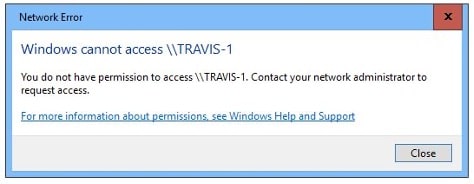
Red flags every business should be on the lookout for
It’s almost 11am, and while you are wrapping up your 3rd back-to-back Zoom call in a row, your computer gets a pop-up saying “cannot access file share”. And then you get a call saying that there’s another IT outage:

It turns out that your MSP was doing “maintenance” and scheduled an update to happen on the server at 11am when they meant for it to happen at 11pm. While mistakes can and will happen, this is now the third major outage in the last 6 weeks. And even worse, the explanation of what went wrong seems to vary depending on who you speak with at the MSP. As a business, you can’t continue like this any longer. It’s having a material impact to the company’s bottom line.
At Xterra, we meet with our clients to learn about their businesses strategy and how technology can be used to their advantage. That said, most new clients find us after a crisis or after years of dissatisfaction with their existing provider. Our priority is try to understand the pain points to determine whether we are the right partner to help make technology a source of innovation, not a constant frustration. Over the past decade, we’ve met with hundreds of companies and have heard our fair share of horror stories from benign support issues to egregious breaches of trust. In this article, we’ve compiled the top 10 reasons people replace their MSP. We also provide some resources to get you into a healthier IT support model if the relationship can be mended. After all, bad MSP partnerships are just like personal relationships in that they start to feel normal if you stay in a bad situation for too long. The best way to deal with this is to get out or to renegotiate on healthier terms.
These days, IT support comes in a variety of forms from full-time staff, hiring part-time gig workers, to outsourcing to a Managed Services Provider (MSP). For the purposes of this post, we’re going to refer them all as an MSP.
10 signs you should fire your Managed Services Provider (MSP)
- Lack of integrity
- Major security incident(s)
- Lack of focus & attention on your business
- Same problems keep happening — again (and again)
- Tech’s aren’t familiar with your environment
- Poor communication / responsiveness
- Lack of technical skills
- You (the client) are the network monitoring system
- Poor IT Lifecycle Management
- Low customer satisfaction
Lack of Integrity
Honesty and integrity are the foundation for all relationships. Once an MSP has shown themselves to lack integrity in their commitments, their work product, or their word, it’s difficult to recover from this type of breach of trust. From our perspective, this is the foundation of the partnership. If you can’t trust your MSP, get out now.
Major Security Incident(s)
Security breaches are one of the biggest reasons to hire a competent MSP. The average cost of a security breach in the US last year was $4 Million for all the costs of data recovery, hiring forensics, and rebuilding after a major breach. Part of good security is understanding how it all fits together, not just running an antivirus software and calling it done. When your MSP isn’t up to the task of keeping your systems & data secure, they can leave your company exposed and vulnerable to attack. We strongly recommend you work with an MSP that adheres to a security framework such as NIST Cybersecurity Framework (CSF) and can provide a full stack of solutions in every category – Identify, Protect, Detect, Respond, and Recover.
Lack of focus
An MSP’s business may have been acquired by a larger player, an independent consultant may no longer have the cycles to devote to you, or maybe your business has outgrown their capabilities. In any case, this is the case where the MSP no longer meets the needs of your company. Whether they shrunk or you grew, the fit isn’t what it once was.
Same problems keep happening — again (and again)
Ever feel like you’re watching Groundhog Day with your current IT support provider? You called about a performance problem for your computer and the MSP says to reboot. It seems to fix the issue for a day, but it keeps coming back. And every time, they continue to troubleshoot the symptom as if it were the first time you were calling. Instead, your MSP should have a problem management process to identify reoccurring incidents and get to the root cause so that issues don’t fester or continue. If you’ve had a major outage, the MSP should provide an Incident Response or Root Cause Analysis and look for signs they’ve addressed the source of the problem instead of just a symptom.
Tech’s aren’t familiar with your environment
Have you had an “all-star” tech assigned to work with your company and things were going great for some period of time? But eventually, that “all-star” tech lands a sweet new gig somewhere else, and a new tech comes in completely cold and unfamiliar with your environment. Or other times, a MSP grows beyond a certain point and the pool of resources becomes so large that you never deal with the same person twice. In all cases, IT support becomes more difficult, troubleshooting issues takes longer, and service quality is degraded. As a MSP client, you shouldn’t have to worry about any particular engineer being the lynch pin of your IT support. If you wanted that, you could hire a full-time resource or an IT consultant. There are a variety of strategies more mature MSP’s leverage to mitigate this issue:
- Multi-tenant documentation platform that is shared between MSP and Client. This allows information about our client to be documented in a standardized location for everything from: circuit information, line of business application support information, to user onboarding procedures.
- Assign a primary and secondary engineer to each client. All new tickets for a particular client are preferred to go to the primary or secondary engineer as they have the most familiarity with the environment. Also, these engineers are responsible for keeping the shared documentation platform up to date for that client environment. If the ticket does have to go to another tech, they have the same baseline information to work from.
- Leverage standards for hardware, software, and configuration best practices to bring higher levels of security and availability.
Poor communication and a lack of responsiveness
There are many different ways we see this issue play out. First is with the MSP not having the ability to effectively communicate to non-technical audiences. The second is when an MSP is offshoring their support and there is a language gap. The third is when there isn’t any follow-up from the MSP for an ongoing issue and as the client you are having to push the MSP to focus on the problem. More developed MSP’s have a full ticket management process using SLA’s which ensures that issues are addressed in a timely manner and you are never left wondering where things stand.
Lack of technical skills
Hiring and retaining top talent is a challenge for employers everywhere. This is especially true for IT staff and even more challenging in the SF Bay Area. Instead of hiring certified and trained technical resources and heavily vetting them to ensure they are both a technical and (most importantly) a cultural fit, some MSP’s try to solve this problem is by hiring inexperienced resources and try to bring them up to speed via OJT (On the Job Training). We don’t recommend this approach as a general business practice. It leads to lower levels of client satisfaction and is painful for both the client and the tech who has been setup to sink or swim.
You (the client) are the network monitoring system
Have you ever had to call your MSP to tell them that a critical service is offline and for them to take a look? Aren’t they supposed to have proactive monitoring tools in place to identify these types of issues so that you don’t have to? We see this most frequently with clients with on-prem services where the MSP never fully properly setup monitoring during onboarding or as part of new system setups never had the process in place to configure monitoring.
Poor IT Lifecycle Management
While it might seem like you get more value out of an IT asset by keeping it until “the wheels fall off”, this strategy will leave users with higher levels of unplanned downtime as compared to replacing IT assets on a pre-scheduled basis. For our target clients, IT downtime costs significantly in terms of direct labor as well as lost productivity. This makes calculating the financial impact of downtime easier to calculate and justifies a 3-5 year replacement schedule on end-user computers, with replacements divided up equally each year. For systems and network infrastructure, you can get away with longer cycles, but the same approach applies. The end result is predictable technology spend, higher levels of service uptime, and less disruption to the business.
Low Customer Satisfaction
There is the saying that “you can’t manage what you can’t measure”. We have found that the MSP’s with the lowest customer satisfaction are the ones with lower levels of operational maturity and have yet to establish a customer satisfaction (CSAT) management system. This isn’t to say that there aren’t exceptions to the rule. In general, MSP’s without CSAT have lower levels of client satisfaction and are less equipped to recover from service quality issues.
How can Xterra help my business?
Xterra has developed the people, process, and technology to deliver white glove IT services for a fraction of the cost of hiring a full-time staff. We are focused on helping San Francisco Bay Area clients accelerate their adoption of technology solutions to create measurable business value. If you are interested in learning more about how Xterra can help your business, schedule a free consultation.
Aaron is a Partner and Principal Network Architect at Xterra Solutions, Inc. With over 20 years experience, Aaron’s practice areas include security, networking, unified communications, and business continuity. Xterra is a leading managed services provider located in downtown San Francisco.
 Innovation, IT Governance
Innovation, IT Governance